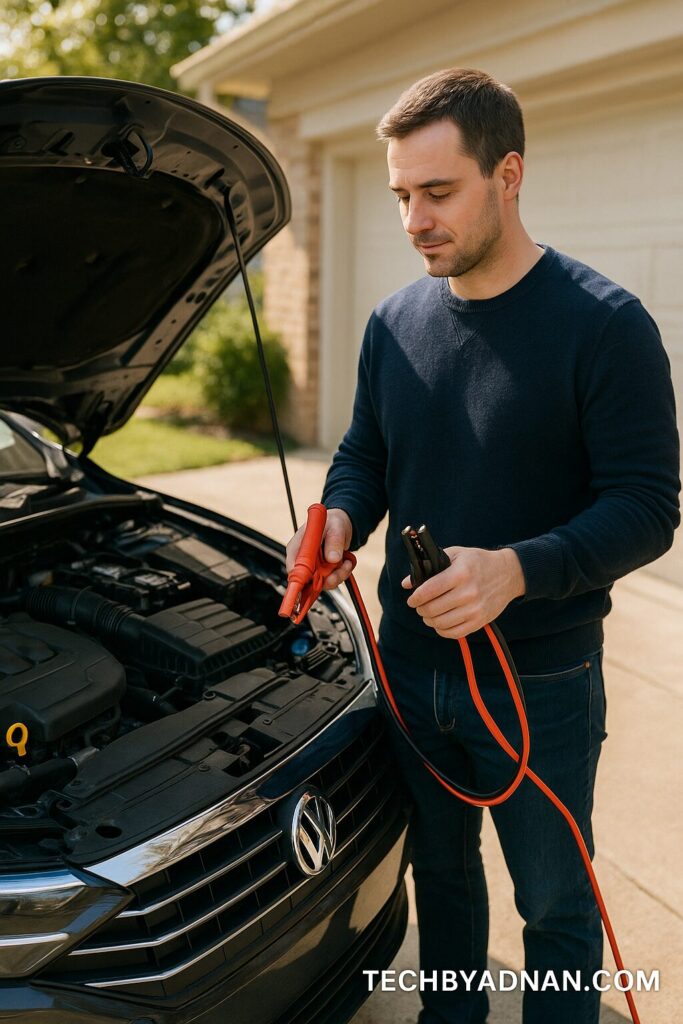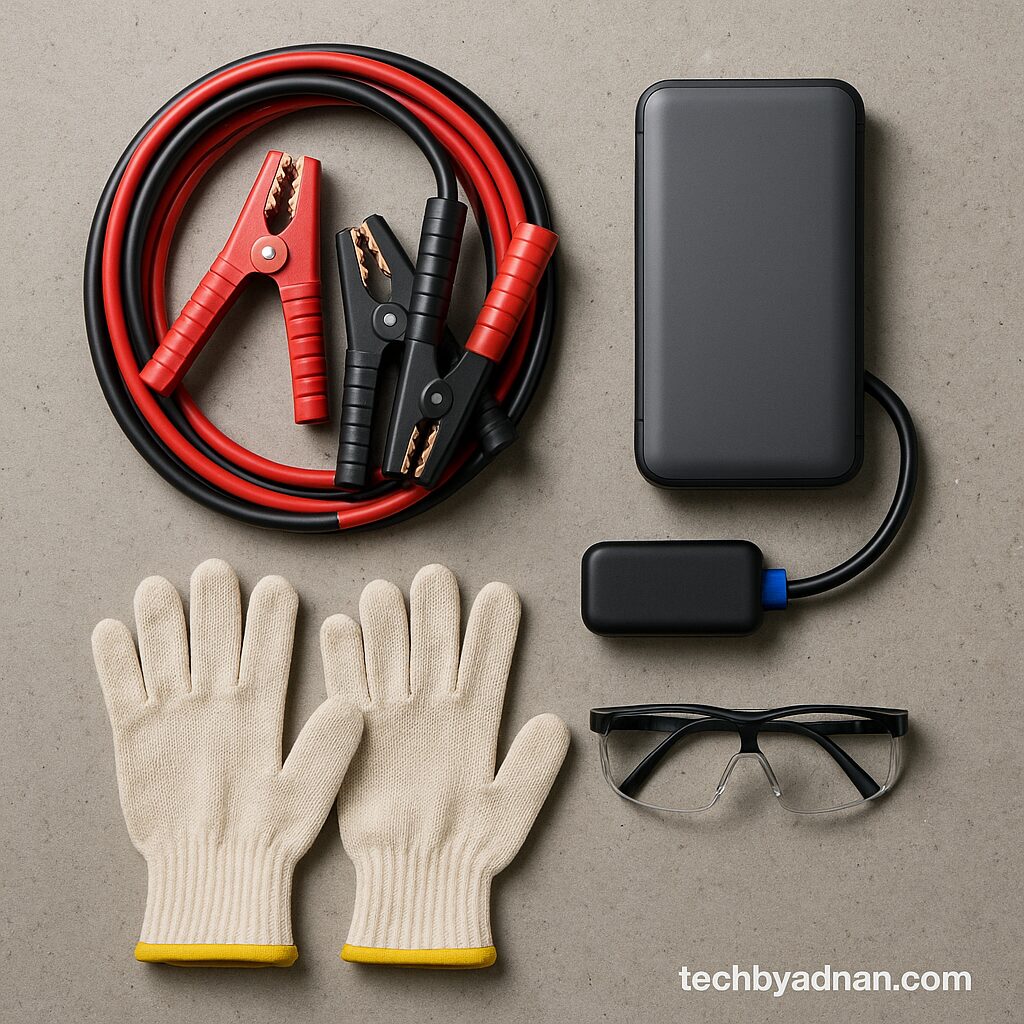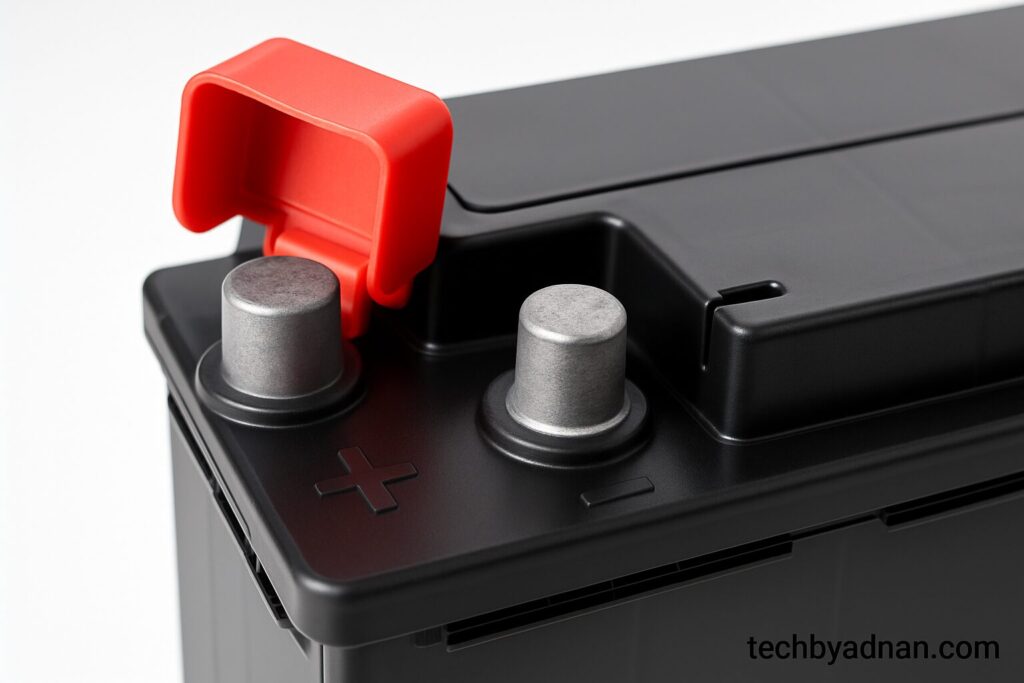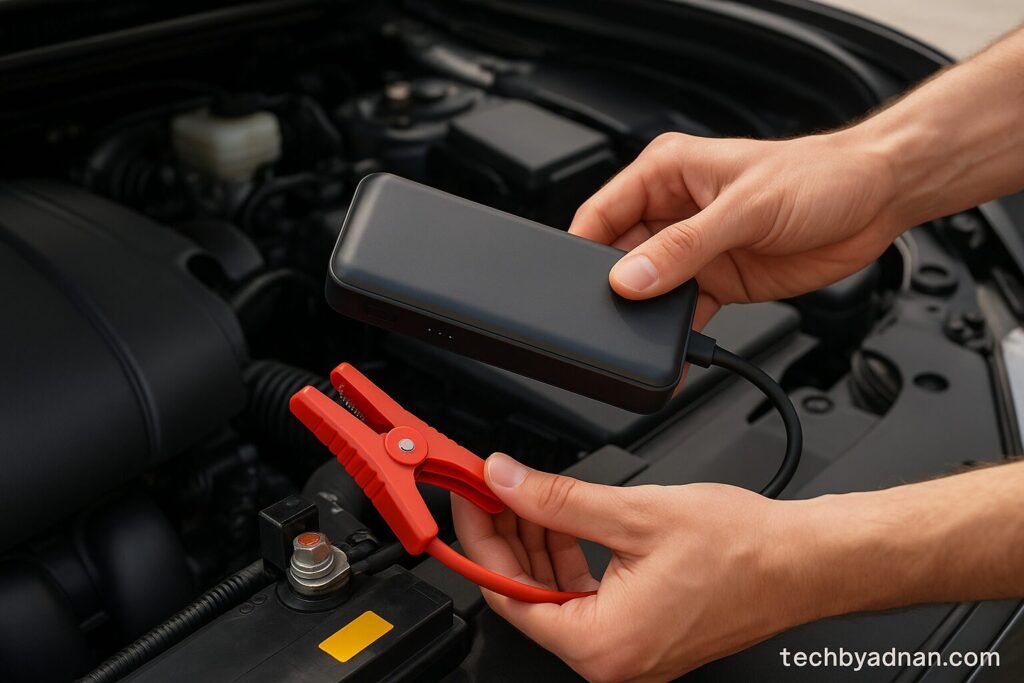There are few sounds more frustrating than the dreaded click, click, click of a car that won’t start. It always seems to happen at the worst possible moment. This guide will walk you through exactly how to jumpstart a car, from the essential safety checks to the exact, step-by-step process for bringing your car back to life.

Whether your car won’t start because you left your headlights on all night, or it’s just one of those cold winter mornings that killed your battery, this guide will get you back on the road. We’ll cover the old-school way with jumper cables and the newer method using those portable jump starters that everyone’s talking about.
The “Before You Begin” Safety & Preparation Checklist
Before we dive into actually jumpstarting your car, let’s talk about getting prepared. I learned this the hard way – rushing into it without proper prep can be dangerous and might even damage your car.
Your Essential Toolkit: More Than Just Cables
High-Quality Jumper Cables
Here’s something I wish someone had told me earlier – not all jumper cables are the same. Those super cheap ones you see at gas stations? They’ll probably fail you when you need them most. We always recommend getting cables that are at least 12 feet long. The thicker, the better. You want ones with heavy-duty clamps that actually grip the battery terminals properly. Trust me on this one.
A Portable Jump Starter
This little device changed my life. Seriously. No more flagging down strangers or waiting for someone to come help you. These things are about the size of a small laptop and can jumpstart your car all by themselves. When you’re shopping for one, look for something with at least 400-600 peak amps. That’s usually enough for most regular cars. Many of them come with cool extras like phone chargers and flashlights too.

Safety Gear
I can’t stress this enough – always wear safety glasses and gloves. Car batteries have acid in them, and sometimes they can spark or even explode if something goes wrong. It might seem like overkill, but it’s really not worth the risk.
Wire Brush
You’ll thank me for this tip later. Battery terminals get all crusty and corroded, especially if your car sits outside a lot. A simple wire brush helps clean them off so you can make a good connection.
Crucial Pre-Jump Inspection: Don’t Skip This!

Assess the Battery’s Health
Before you do anything, take a good look at your battery. If you see any cracks, bulges, or weird fluid leaking out, don’t try to jump it. That battery is done for, and messing with it could be dangerous. I once saw someone try to jump a cracked battery, and let’s just say it didn’t end well.
Check Your Environment
Make sure you’re somewhere safe. If you’re on a busy road, try to move into a parking lot or, at the very least, pull well off to the side. Turn on your hazard lights to warn other drivers you’re there. And here’s something important – never try to jumpstart a car in a garage or any closed space. The gases from batteries can build up and become explosive.
Identify the Battery Terminals
Look for the positive (+) and negative (-) signs on your battery. Usually, the positive terminal has a red cover or red wires going to it, and the negative has black. If there’s a bunch of white, crusty stuff on the terminals, that’s corrosion. Clean it off with your wire brush – it’ll make everything work better.

How to Jumpstart a Car Safely : The Step-by-Step Guide
Alright, here’s the main event. I’m going to walk you through this step by step, exactly like my dad did for me that first time. Don’t worry if it seems complicated – once you do it a few times, it becomes second nature.
Step 1: Get the helper car positioned so the batteries are close enough for your cables to reach, but don’t let the cars touch each other. I typically try to keep a distance of about 2 to 3 feet between the vehicles.
Step 2: Turn off both cars completely. Shift the car into park (or neutral for manual transmissions) and apply the parking brake. We don’t want any surprises here.
Step 3: Open the hoods of both vehicles and locate the batteries. Most of the time they’re right up front, but sometimes they’re in weird places like the trunk. If you’re unsure where it is, refer to your owner’s manual for guidance.
Step 4: Take your red cable and connect it to the positive terminal of the dead battery first. Make sure it’s on there tight – a loose connection won’t work and could be dangerous.
Step 5: Attach the other end of the red cable to the positive terminal on the working battery.
Step 6: Now take your black cable and connect it to the negative terminal of the working battery.
Step 7: Here’s where a lot of people mess up. Don’t connect that other black cable to the negative terminal of the dead battery. Instead, find a piece of unpainted metal in the engine – like a bolt or bracket – and connect it there. This prevents sparks near the battery.
Step 8: Start up the helper car and let it run for a couple minutes. This gives the dead battery a chance to soak up some juice.
Step 9: Now try starting your car. If it doesn’t work right away, don’t panic. Wait another minute or two and try again. Sometimes really dead batteries need a little patience.
Step 10: Once your car starts, you need to disconnect everything in reverse order. First, remove the black cable from the grounded surface, then the black cable from the helper car. Next, disconnect the red cable from the helper car, followed by the red cable from your own battery. Keep both engines running while you do this.
The Modern Way: A Portable Jump Starter Guide
These portable jump starters are honestly amazing. I bought one after getting stranded at a grocery store and having to ask random people for help. Never again! Here’s how to jump a car without another vehicle:
1. Inspect the Pack: Before anything else, ensure your jump starter is fully charged. Most of them have little LED lights that tell you how much juice they have left. If it’s dead, well, you’re back to the old-fashioned method.
2. Connect the Clamps: Red clamp goes to the positive terminal of your battery, black clamp goes to a ground point in the engine (just like before, not the negative battery terminal).
3. Turn it On: Switch on your jump starter. Some of them are smart and won’t work if you’ve got the connections wrong, so don’t worry if nothing happens at first – just double-check your clamps.
4. Start Your Car: Turn the key and give it a try. If it doesn’t work immediately, wait a minute and try again. These things usually have enough power to get you going.
5. Disconnect: Once your car starts, turn off the jump starter and take off the clamps. Black first, then red. Your car should keep running on its own now.
What to Do After a Successful Jump-Start
Okay, so your car is running again. You probably want to get going, but hold on a second. There are a few things you need to do to make sure you don’t end up stuck again in an hour.
Keep It Running
Don’t turn off your engine yet. Your battery needs time to charge back up, so let it run for at least 30 minutes. If you turn it off too soon, you might be right back where you started.

Take a Drive
Just sitting there idling isn’t the best way to charge your battery. Take your car for a good drive – highway driving is perfect because your engine runs faster and charges the battery better. We usually recommend driving for at least 30-60 minutes.
Test Your Battery
After your drive, turn off the car and wait a few minutes. Then try starting it again. If it starts up easily, you’re probably good to go. If it struggles or won’t start, your battery might be on its way out.
Go Easy on the Extras
While your battery is recovering, try not to use things like air conditioning, heated seats, or the radio unless you really need them. Give your charging system a break.
How to Jumpstart a Car By Yourself (Using a Portable Starter)
There’s something really empowering about being able to handle this on your own. No more waiting for help or bothering friends and family. Here’s what we’ve learned about doing it solo:

Safety First
When you’re by yourself, you need to be extra careful. Make sure you’re in a safe spot, put on your hazard lights, and don’t rush. Most mistakes happen when people are in a hurry.
Follow the Portable Process
Just use the portable jump starter method I outlined above. The great thing about these devices is you don’t have to coordinate with another driver or worry about positioning two cars.
Stay Calm
If your car doesn’t start on the first try, take a deep breath. Check your connections, wait a couple minutes, and try again. Sometimes batteries that are really dead need a little time to wake up.
Have a Backup Plan
Even with a portable jump starter, sometimes things don’t go as planned. Make sure your phone is charged and you have numbers for roadside assistance or a mechanic you trust.
Troubleshooting: “My Car Still Won’t Start!”
So you’ve done everything right, but your car is still being stubborn? Don’t give up yet. Here are some things to check:

Check Your Connections
This is usually the problem. Make sure all the clamps are tight and making good contact. Sometimes there’s so much corrosion that even tight clamps don’t make a good connection.
Wait Longer
If your battery was completely dead, it might need more time to take a charge. Try waiting 5-10 minutes with everything connected before trying to start.
It Might Not Be the Battery
If your lights and radio work but the car won’t start, you might have a different problem. Could be your starter, alternator, or even something as simple as being out of gas.
Temperature Matters
Really cold weather makes batteries work terribly. In the winter, you might need to be more patient or use a more powerful jump starter.
Call for Help
If you’ve tried everything and your car still won’t start, it’s time to call a professional. Some problems just need special tools and know-how.
Final Conclusion
Learning how to jumpstart a car is honestly one of those skills that every driver needs to know. It’s like knowing how to change a tire – you hope you never need it, but when you do, you’ll be so glad you learned.
The most important thing to remember is safety. Take your time, follow the steps, and don’t be afraid to ask for help if something doesn’t seem right. We’ve all been there, and most people are happy to help out a fellow driver in need.
A portable jump starter is really worth the investment. It gives you peace of mind and independence, and you can help other people too. There’s nothing quite like being the hero who saves someone’s day in a parking lot.
The best way to avoid dead battery situations is to pay attention to your car. If it’s been starting slower lately, or if your battery is getting old, get it tested before it leaves you stranded. It’s much easier to replace a battery at your convenience than to deal with a dead one when you’re already running late.
Remember, even experienced drivers deal with dead batteries sometimes. It’s just part of owning a car. The key is being prepared and knowing what to do when it happens. With this guide and a little practice, you’ll be ready for whatever your car throws at you.
Stay safe out there, and remember – every expert was once a beginner. You’ve got this!
Frequently Asked Questions (FAQs)
How much time does it usually take to jumpstart a car?
Usually just a couple minutes once everything is hooked up right. Really dead batteries might take a bit longer to get enough charge to start the engine.
Can I jumpstart a car when it’s raining?
We really don’t recommend it because of the risk of getting shocked. If you absolutely have to do it, wear rubber gloves and be super careful to keep water away from all the electrical stuff.
How often should I replace my car battery?
Most batteries last about 3-5 years. If you’re constantly dealing with a dead battery, especially if it’s over 3 years old, it’s probably time for a new one.
Can jumpstarting hurt my car?
When you do it right, it’s totally safe. But if you mess up the steps, you could damage some expensive electronics. That’s why we always say to follow the proper steps and check your owner’s manual for any special instructions.
What’s better – jumper cables or a portable jump starter?
Both have their place. Jumper cables are cheaper and don’t need charging, but you need another car. Portable jump starters cost more upfront and need regular charging, but they give you complete independence.
Why does my battery keep dying?
If it keeps happening, you probably either need a new battery, have a problem with your charging system, or something in your car is draining power when it’s supposed to be off.
Can I jumpstart a hybrid or electric car?
Hybrid cars can usually be jumpstarted, but electric cars are totally different. Check your owner’s manual because some cars have special procedures or warnings.
READ MORE ARTICLES
How Do I Get TikTok Back on My iPhone in 2025?
How to Know If Someone Blocked You on iMessage
IPhone 15 Pro Max Price In India Drop? See the Latest Prices
How to Delete Photos from Google Photos on Android, iPhone & Web
iPhone 17 Pro Max Price in Pakistan 2025: Everything You Need to Know
How to Unpair Apple Watch: Complete Guide [2025 Updated]
Poly AI (PolyBuzz) Complete Guide 2025: Safety, Features, Pricng
